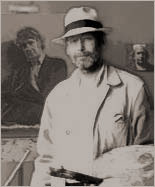This article has multiple issues. Please help improve it or discuss these issues on the talk page . (Learn how and when to remove these messages)
|
Frans Koppelaar | |
|---|---|
 Self portrait of Frans Koppelaar | |
| Born | Frans Thomas Koppelaar April 23, 1943 |
| Nationality | Dutch |
| Known for | Painting, Landscape art |
Frans Thomas Koppelaar (born April 23, 1943) is a Dutch painter, who was born in The Hague, Netherlands.
Contents
From 1963 to 1969, he attended the Royal Academy of Visual Arts at The Hague. He moved to Amsterdam in 1968. [1]
His landscapes and Amsterdam cityscapes are painted in a style that recalls the classical tradition of the Hague School and the Amsterdam Impressionists. [2]
Koppelaar's work is congenial to a figurative movement in Dutch contemporary painting that evolved during the 1990s in a reaction to the pared-down conceptual art and the too pompous art-theories of that period. Through the years his style evolved into a simpler, straightforward approach. [3] By 1984, he no longer identified himself with any art movement.
Koppelaar is also known as a portraitist. [1]

oil on canvas